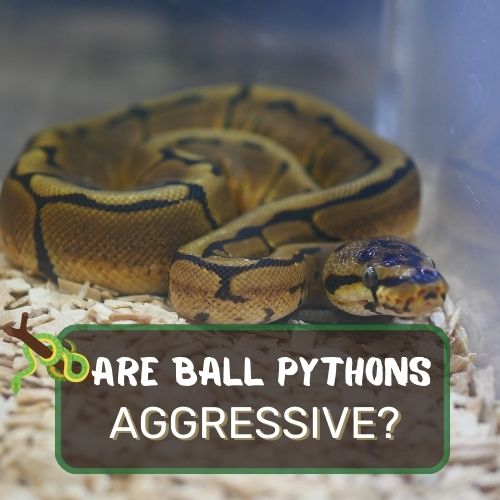
When the question “Are ball pythons aggressive?” arises, many potential reptile owners find themselves seeking clarity.
Ball pythons, with their captivating patterns and gentle eyes, have become a popular choice among pet enthusiasts.
But how do they fare in terms of temperament? In this article, we’ll delve deep into the nature of ball pythons, debunking myths and shedding light on their true behavior.
We’ll explore factors like their origin, behavior in the wild, and common triggers for defensive actions.
By the end, you’ll have a comprehensive understanding of these fascinating creatures and whether they’re the right fit for your home.
Dive in to discover the world of ball pythons and their true nature.
Table of Contents
- 1 Are Ball Pythons Aggressive? (Short Answer)
- 2 Understanding the Nature of Ball Pythons
- 3 Ball Pythons: A Closer Look
- 4 Are Ball Pythons Really Aggressive?
- 5 Ball Pythons as Pets
- 6 Handling and Socializing Your Ball Python
- 7 Other Friendly Snakes to Consider
- 8 Potential Challenges with Ball Pythons
- 9 Wrapping it up
- 10 Frequently Asked Questions
Are Ball Pythons Aggressive? (Short Answer)
Ball pythons, native to West and Central Africa, are renowned for their docile temperament, making them a favorite among reptile enthusiasts. In general, they are not aggressive creatures. Instead, they tend to be shy and might curl into a ball when threatened, which is how they got their name. However, like any animal, they can become defensive if they feel threatened or are not handled correctly.
It’s essential to approach them with care, especially if they’re not accustomed to being handled. With regular, gentle interaction, ball pythons usually become quite comfortable with their human caregivers and display minimal aggressive behavior.
Understanding the Nature of Ball Pythons

Ball pythons are fascinating creatures, and understanding their nature can shed light on the question, “are ball pythons aggressive?” Let’s dive deep into their world.
Origin and habitat
Ball pythons hail from the grasslands of West and Central Africa. They thrive in warm, tropical climates and are often found hiding in burrows, which they don’t dig themselves but rather take over from small mammals.
This environment plays a significant role in shaping their behavior. In the wild, they’re exposed to various predators, which has made them masters of camouflage and evasion.
Physical characteristics
A ball python’s physical features are not just about aesthetics; they’re survival tools. Their scales, which come in various patterns and colors, help them blend seamlessly into their environment.
Adult ball pythons can grow up to 5 feet long, but despite their size, they have a relatively stocky build. Their eyes, which are set on the top of their head, give them a good vantage point to keep an eye out for threats.
Their behavior in the wild
Now, to the heart of the matter: are ball pythons aggressive in the wild? The answer is, not really. Ball pythons are more about defense than offense. When threatened, their first instinct isn’t to attack but to hide.
This is where their name comes into play. When they sense danger, they curl up into a tight ball, tucking their head inside, hence the name “ball python.” This behavior is their way of protecting their most vulnerable parts.
In the wild, ball pythons are nocturnal hunters. They rely on their keen sense of smell and heat-sensing pits to locate prey.
But even in hunting, they’re more about strategy than aggression. They patiently wait for the right moment to strike, constricting their prey with precision.
Labeling ball pythons as aggressive is a misconception. They are, in fact, quite the opposite. Their behavior, both in the wild and in captivity, leans more towards being defensive and cautious.
Understanding their nature and respecting their boundaries can lead to a harmonious relationship between humans and these remarkable reptiles.

Ball Pythons: A Closer Look
When you think of snakes, the image that often comes to mind might be that of a long, slithering creature with a menacing look.
But ball pythons? They’re a different story altogether. Let’s take a closer look at these intriguing reptiles.
Physical characteristics: size, color, and patterns
Ball pythons are a visual treat. They typically range from 3 to 5 feet in length when fully grown, making them a manageable size for many snake enthusiasts.
Their bodies are adorned with intricate patterns that can vary from one individual to another. These patterns, often in shades of brown, black, and gold, not only add to their aesthetic appeal but also serve as camouflage in the wild.
Over the years, breeders have introduced various morphs, leading to ball pythons in a rainbow of colors and unique patterns, making them even more sought after in the pet trade.
Natural habitat and behavior
Originating from the grasslands and open forests of West and Central Africa, ball pythons are accustomed to a warm and humid environment.
In the wild, they’re primarily nocturnal creatures, preferring to hunt at night and avoid the scorching daytime heat. Their behavior is characterized by their tendency to be shy and reclusive.
When faced with potential threats, they often choose to hide or, as their name suggests, curl into a protective ball rather than confront or attack.

Are Ball Pythons Really Aggressive?
The question of aggression in ball pythons is one that’s been debated and misunderstood for years. So, let’s set the record straight.
Debunking myths about ball python aggression
First and foremost, ball pythons are not inherently aggressive creatures. Many myths and misconceptions surround snakes in general, leading to unfounded fears.
Stories of ball pythons attacking unprovoked are often exaggerated or taken out of context.
Factors that can lead to aggressive behavior in snakes
Snakes, like all creatures, have their own set of behaviors and responses to their environment. While they’re often misunderstood and labeled as aggressive, it’s essential to recognize that any aggressive behavior usually stems from specific triggers.
Let’s delve into some of the primary factors that can lead to such behavior in snakes:
- Stress: Just as with humans, stress is a significant factor in a snake’s behavior. Changes in their environment, frequent handling, or even the presence of other animals can stress them out. A stressed snake is more likely to exhibit aggressive behavior as a defense mechanism.
- Improper Handling: Snakes need to be handled with care and respect. Sudden or forceful handling can frighten them, leading to defensive strikes. It’s crucial to approach them calmly and give them time to get used to your presence.
- Illness or Injury: A snake that’s unwell or injured is more likely to be irritable. Pain or discomfort can make them more defensive and less tolerant of any disturbances.
- Feeding Time: Snakes can become more aggressive around feeding time. Their predatory instincts kick in, and they might mistake a hand for food, leading to unintentional bites.
- Mating Season: Hormonal changes during the mating season can lead to increased aggression in some snake species. Male snakes might become more territorial, while females might become more protective.
- Shedding Period: Shedding is a vulnerable time for snakes. Their vision is compromised, and they might feel more threatened, leading to heightened defensive behavior.
Understanding these factors is the first step in ensuring a harmonious relationship with a pet snake.
By being aware of potential triggers and addressing them proactively, one can minimize aggressive behavior and foster trust between human and reptile.
The difference between defensive behavior and genuine aggression
There’s a fine line between a snake being defensive and genuinely aggressive. A defensive ball python might hiss, strike, or curl into a ball when feeling threatened. This behavior is a reaction to a perceived threat.
On the other hand, genuine aggression is rare and is often linked to underlying issues like health problems or extreme stress. Understanding this distinction is crucial for anyone considering a ball python as a pet.
Ball pythons, with their gentle nature and captivating appearance, make fantastic pets for those willing to understand and cater to their needs.
With proper care and understanding, aggressive behavior can be minimized, leading to a harmonious relationship between owner and snake.

Ball Pythons as Pets
Ball pythons have carved a niche for themselves in the hearts of reptile enthusiasts worldwide. But what makes them such a sought-after pet?
Their ranking as the most popular pet snake
When it comes to pet snakes, ball pythons reign supreme. Their manageable size, combined with their docile nature, has earned them the title of the most popular pet snake.
Whether you’re a seasoned herpetologist or a newbie to the world of reptiles, ball pythons are often the go-to choice.
Benefits of having a ball python as a pet
Ball pythons, with their mesmerizing appearance and gentle nature, have become a favorite among reptile enthusiasts. But their allure goes beyond just their looks.
Here’s why having a ball python as a pet can be a truly rewarding experience:
- Low Maintenance: Unlike many other pets, ball pythons don’t require daily walks or frequent feeding. Their dietary needs are straightforward, and with a well-set-up enclosure, their day-to-day care is relatively simple.
- Long Lifespan: With proper care, ball pythons can live up to 30 years or more. This means you’re committing to a long-term companion who will be with you for a significant part of your life.
- Educational Value: Owning a ball python can be a continuous learning experience. From understanding their biology to observing their behaviors, they offer endless educational opportunities, especially for children.
- Space-Efficient: Ball pythons don’t need a vast space to thrive. A well-sized terrarium can comfortably house them, making them suitable for both large homes and smaller apartments.
- Therapeutic Presence: Many ball python owners find solace in watching their snake’s slow, graceful movements. Their quiet presence can be calming, offering a unique form of pet therapy.
- Conversation Starter: Not everyone has a snake as a pet. Owning a ball python can spark interest and curiosity, making for great conversations with friends and family.
In essence, ball pythons are not just pets; they’re companions that offer a blend of aesthetic appeal, educational insights, and emotional comfort.
The importance of getting captive-bred ball pythons for better temperament
While wild-caught ball pythons are available, opting for captive-bred ones is a wise choice. Captive-bred ball pythons are generally healthier, free from parasites, and have a more predictable temperament.
They’re accustomed to human interaction from a young age, making them more amenable to handling and less prone to stress.

Handling and Socializing Your Ball Python
Building a bond with your ball python is a rewarding experience. But how do you ensure that your slithery friend is comfortable in your company?
Importance of regular handling to ensure a docile temperament
Regular, gentle handling is the key to a docile ball python. It helps them get accustomed to human touch and reduces the likelihood of defensive behavior.
Over time, with consistent interaction, your ball python will begin to recognize you and even look forward to your handling sessions.
Tips for handling ball pythons safely
- Approach calmly: Quick or sudden movements can startle your snake. Approach them slowly and gently.
- Support their body: When lifting your ball python, ensure you support their body, especially the midsection, to make them feel secure.
- Avoid handling after feeding: Give your snake a day or two after feeding before handling them to prevent regurgitation.
Signs that your ball python might be stressed or uncomfortable
- Hissing or striking: While ball pythons are generally quiet, hissing or striking can indicate discomfort.
- Rapid breathing: Quickened breaths can be a sign of stress or fear.
- Curling into a tight ball: This defensive posture means your snake feels threatened.
In conclusion, ball pythons, with their captivating charm and gentle nature, make for delightful pets. By understanding their needs and ensuring regular, gentle handling, you can foster a deep bond with your scaly companion.

Other Friendly Snakes to Consider
While ball pythons often steal the limelight when it comes to friendly snakes, they’re not the only ones with a docile disposition.
The world of reptiles is vast, and there are several other snakes that are equally deserving of attention for their gentle nature.
Corn Snake
Corn snakes, with their vibrant colors and patterns, are a favorite among beginners and seasoned herpetologists alike. Native to the southeastern United States, these snakes are known for their curious nature.
They’re active, enjoy exploring their surroundings, and are generally tolerant of handling. Their care requirements are similar to ball pythons, making them an excellent alternative for those looking for a friendly snake.
Rosy Boa
The Rosy Boa, with its smooth scales and distinct color bands, is another snake that’s perfect for those new to the world of reptiles. They’re smaller than ball pythons, usually reaching lengths of 2 to 3 feet.
Their calm demeanor and minimal care requirements make them a popular choice among snake enthusiasts.
Hognose Snake
Hognose snakes are truly unique, thanks to their upturned snouts. They’re known for their dramatic displays, often playing dead when threatened.
But don’t be fooled by their theatrics; hognose snakes are generally docile and rarely show any aggressive behavior. They’re also relatively small, making them easy to handle and care for.
Comparison of their temperaments with ball pythons
While all these snakes are known for their friendly nature, there are subtle differences in their temperaments.
Ball pythons, for instance, are more laid-back and might prefer to curl up and relax, whereas corn snakes are more active and curious.
Rosy boas and hognose snakes, on the other hand, are somewhere in between, being both curious and content to chill out.
However, all these snakes, when treated with respect and care, are less likely to display aggressive behavior and can become wonderful companions.

Potential Challenges with Ball Pythons
Every pet comes with its set of challenges, and ball pythons are no exception. However, understanding these challenges can lead to a more harmonious relationship with your slithery friend.
Feeding Issues
One of the primary concerns with ball pythons is their occasional reluctance to eat. Factors like stress, shedding, or even seasonal changes can affect their appetite.
It’s essential to monitor their feeding habits and consult a vet if they refuse food for extended periods.
Shedding Problems
Shedding is a natural process for snakes, but sometimes, ball pythons might face issues like incomplete sheds. Ensuring proper humidity levels in their enclosure can help alleviate such problems.
Mistaking Challenges for Aggression
Often, challenges like feeding issues or shedding problems can be mistaken for aggression. A ball python that’s about to shed might become more reclusive or even hiss if disturbed. Similarly, a hungry snake might strike out of frustration.
Understanding these behaviors and addressing the root causes can ensure a happy and healthy ball python.

Wrapping it up
As you’ve journeyed through this article, you’ve unraveled the mysteries surrounding the temperament of ball pythons. These captivating creatures, often misunderstood, are generally docile and make for wonderful companions.
You’ve learned about their origins, their behavior in the wild, and the factors that might influence their actions. It’s essential to remember that, like any animal, understanding and patience are key.
By respecting their boundaries and providing them with the care they need, you can foster a harmonious relationship with these reptiles.
Ball pythons, with their gentle nature and intriguing patterns, offer a unique pet experience that few other animals can match.
As you consider bringing one into your home, or if you’re just fascinated by their world, take this knowledge with you. Let it guide your interactions and deepen your appreciation for these remarkable creatures.
Remember, every ball python is an individual, and with the right approach, they can become a cherished part of your life. Embrace the adventure and the learning opportunities that come with it.
You’re well-equipped to make informed decisions and to enjoy the world of ball pythons to the fullest.
Frequently Asked Questions
Navigating the world of ball pythons can be filled with questions, especially for those new to these captivating creatures. Let’s address some of the most commonly asked questions about ball pythons.
Do ball pythons bite hard?
Ball pythons, like all snakes, have the capability to bite. However, their bites are usually not very powerful, especially when compared to larger snake species. If a ball python does bite, it’s often more of a surprise than a severe injury. Proper handling and understanding their behavior can significantly reduce the chances of a bite.
Are ball pythons aggressive towards each other?
While ball pythons are generally docile towards humans, they can be territorial with other snakes. It’s not recommended to house multiple ball pythons in the same enclosure, as this can lead to stress, competition for resources, and potential aggression.
Do ball pythons hiss a lot?
Hissing is a defensive behavior in snakes. Ball pythons might hiss if they feel threatened or stressed. However, they’re not known to hiss frequently. Regular handling and a comfortable environment can help reduce such behaviors.
Are ball pythons good for beginners?
Absolutely! Ball pythons are often recommended for beginners due to their manageable size, docile nature, and relatively simple care requirements. They’re a great introduction to the world of reptiles and can be a rewarding pet for both novices and seasoned herpetologists.




0 Comments